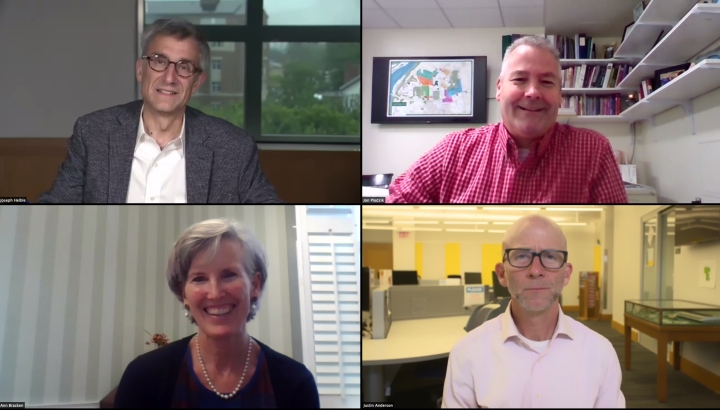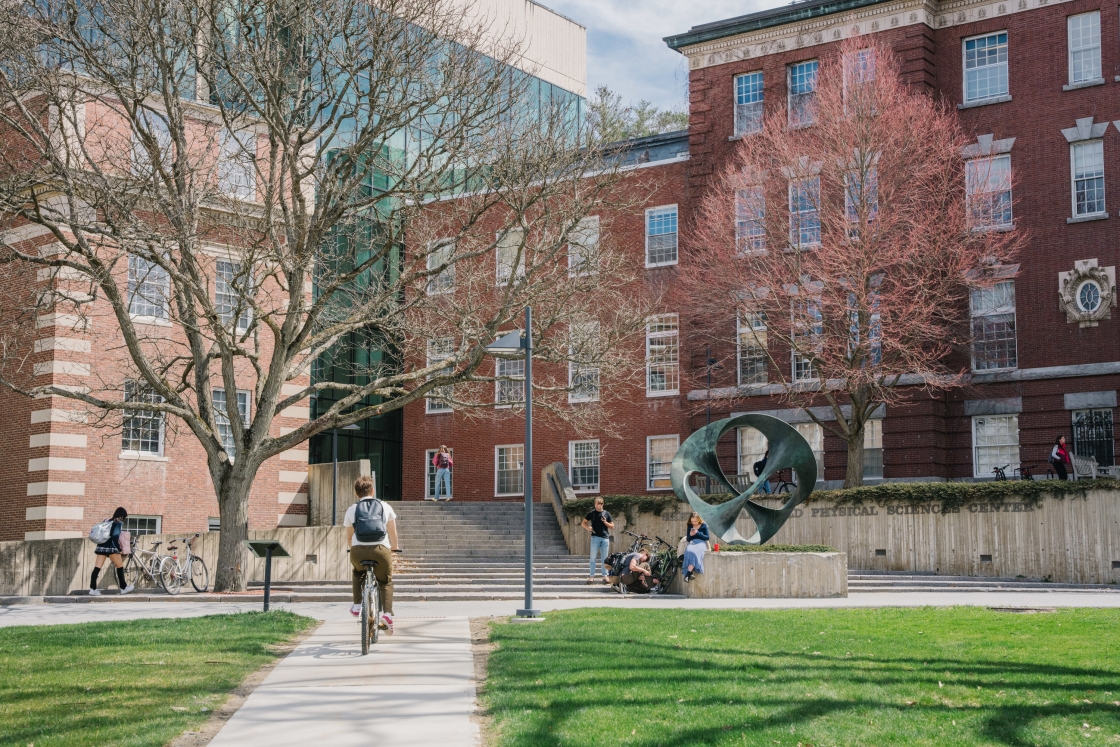Next week’s return of half the undergraduate student population to campus is an opportunity for students—and the entire Dartmouth community—to learn, live, and work together while successfully navigating the challenges presented by the COVID-19 pandemic, Provost Joseph Helble said on Wednesday’s Community Conversations webcast.
The undergraduates will join graduate and professional students who have already started their terms while research labs and the Dartmouth Library have continued their opening processes. Last week Helble and President Philip J. Hanlon ’77 announced their decision to bring half of the undergraduate population back to campus to take classes, mostly remotely, while living in residence halls. The remaining students will take remote classes from their homes. Most undergraduates will have the opportunity to spend two terms on campus.
Some area residents have criticized the decision to bring students back to campus, but the president and provost have expressed confidence in Dartmouth’s comprehensive virus testing program, quarantine procedures, and the health and safety guidelines that have been put in place. This is, Helble said, an important moment for Dartmouth.
“This is the opportunity for us, for Dartmouth, to show what can be done when we work together and support one another, this is our moment,” he said. “This is not the fall that any of us envisioned, but what we do and how we traverse these challenging times will define us as a community.”
Dartmouth is working closely with the New Hampshire Division of Public Health Services on case monitoring and contact tracing. There have been almost 1,200 tests administered on campus to date, with no positive results for the virus. A dashboard was posted on Dartmouth’s COVID-19 website yesterday to publicly report the numbers of tests, confirmed cases, and people in isolation and quarantine on campus. The site will be updated every Monday and Thursday. If needed, Dartmouth has set aside more than 550 beds for isolation and quarantine, Helbe said.
The provost was joined on the webcast by physician Ann Bracken, director of clinical medical services at the Dartmouth College Health Service, and Jon Plodzik, director of Dartmouth Dining.
Bracken explained what undergraduates will encounter when they arrive on campus. They will report to a testing area under a large tent at the corner of Rope Ferry Road and Maynard Street, where Bracken said as many as 1,800 people can be tested in a day.
“They will get screened for symptoms, they register and do the test, they come around the corner and go into another tent where they get their key, and a bag of goodies—including some cleaning supplies and masks and information about how to check their results—and then they go to their room,” she said.
In addition, students are taking pre-arrival tests, and after their arrival-day test will be tested again on days three and seven. To date, more than 700 students have completed pre-arrival testing, and as of Wednesday, one student had tested positive, Bracken said.
“We have contacted that student and made recommendations about isolating at home,” she said. Dartmouth follows the CDC guidelines, which call for 10 days of isolation, being fever-free for at least 24 hours, and exhibiting improving symptoms, before a patient can return to activities. “Once the student completes this isolation, we will welcome them into our community.”
Helble said that the testing and arrival procedures are extraordinary, but necessary. They are, “in some way like a military operation,” he said.
“These first few weeks on campus will go such a long way towards defining the success of the rest of the term, defining the success of subsequent terms. These first few weeks will go such a long way towards instilling confidence in the members of our community who are a little bit apprehensive around the return of half of our undergraduate student body to campus,” he said, adding that it is crucial “to understand how important it is that we execute this successfully.”
Plodzik explained that dining staff will deliver meals to residence halls while students are quarantining for their first 14 days on campus. Then, sometime around the last week of September, dining facilities are expected to begin to open with a plan to accommodate students at safe physical distances.
“Everyone should really rest assured that they will not go hungry during this period of time,” he said. The dining staff will prepare the regular menu, and, as always, offer options for a variety of dietary requirements. “I don’t think any student or family should worry about being hungry. We have plenty of food and we’ll make sure that you get it.”
Community Conversations is an online forum for Dartmouth community members to ask questions and learn from campus leaders about the institution’s priorities, decisions, and operations during the pandemic. The live discussions, produced by Dartmouth’s Media Production Group and the Office of Communications, air on selected Wednesdays at 3:30 p.m. The next webcast is set for Sept. 16. Past episodes are available on the Community Conversations site, which also includes call-in numbers for those who want to listen to the show without video. Find out how to watch or listen to the live webcast.
For the most recent information on Dartmouth’s response to the pandemic, visit the COVID-19 website.


